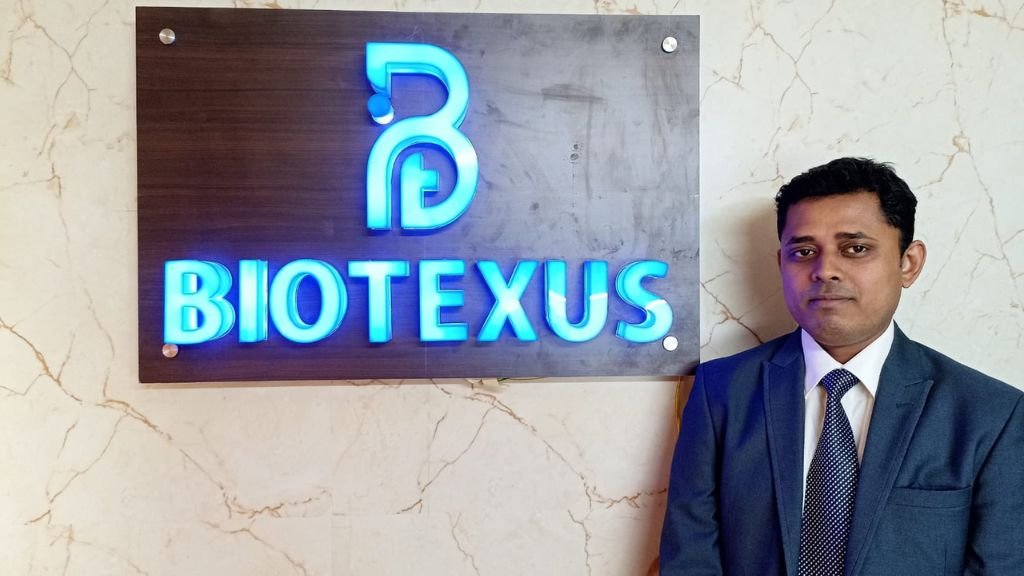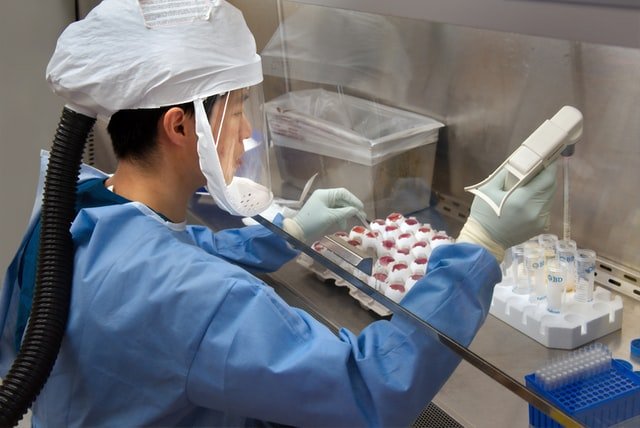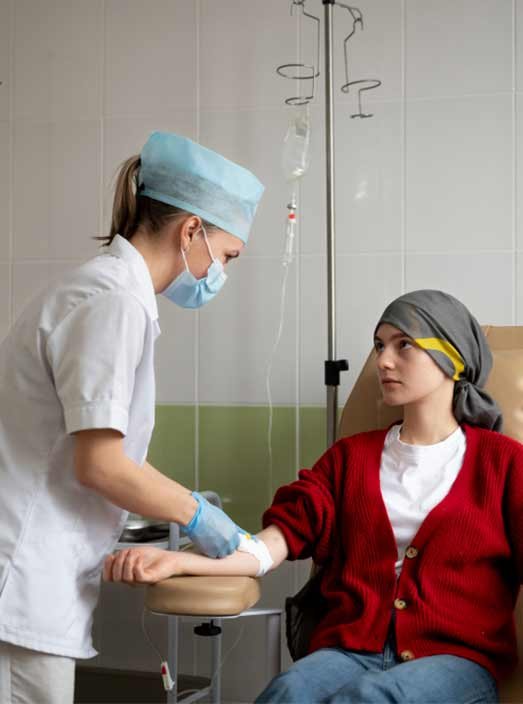LIVER
- Biotexus
- July 30, 2024
About the liver
The liver is the largest internal organ in the body. It is essential for food digestion. Nobody can exist without a liver. Liver functions include:
- Blood collection and filtration from the intestines
- Processing and storing nutrients taken through the intestines
- converting certain nutrients into energy or chemicals required for tissue repair and growth
- Producing some of the body’s blood-clotting factors
- Toxin removal from the body
- Maintaining the body’s proper sugar level
About liver cancer :
Cancer develops when healthy cells mutate and expand uncontrollably, generating a mass known as a tumor. A tumor might be malignant or benign. A malignant tumor is one that can develop and spread to other regions of the body. A benign tumor is one that can develop but does not spread.
Types of primary liver cancer in adults :
- Hepatocellular carcinoma (HCC): Hepatocellular carcinoma can develop in a variety of ways. Tentacle-like growths spread throughout the liver in certain cases. This is the most popular pattern in the United States.Hepatocellular carcinomas account for approximately 75% of all primary liver malignancies in adulthood.
- cholangiocarcinoma: Cholangiocarcinoma arises from cells in the liver’s bile duct. The bile duct is a narrow tube that connects the liver to the small intestine. The bile duct begins inside the liver as a series of smaller tubes that connect.
Cholangiocarcinomas account for 10% to 20% of all primary liver cancers in adulthood.
- Angiosarcoma : Angiosarcoma begins in the blood vessels of the liver and spreads rapidly.
Angiosarcomas account for around 1% of all primary liver malignancies in adulthood.
Risk Factors :
The following factors can raise a person’s risk of developing liver cancer. The main risks in the United States are cirrhosis of the liver and non-alcoholic fatty liver disease (NAFLD).
Cirrhosis. Cirrhosis develops when destroyed liver cells are replaced by scar tissue. Alcohol misuse is the leading cause of cirrhosis in the United States.
Obesity, NAFLD, and diabetes. Obesity causes fat to accumulate in the liver, resulting in NAFLD.
Viral hepatitis. The viruses that cause hepatitis invade the liver. Hepatitis B and C are the most frequent kinds. Viral hepatitis is the leading cause of liver cancer in the globe.
Age. Adult primary liver cancer is most common in adults over the age of 60 in the United States.
Gender. Men are more prone to acquire liver cancer than women.
Environmental factors. Some environmental variables, such as exposure to certain chemicals or eating food tainted with aflatoxin, may raise the risk of liver cancer.
Symptoms
People with liver cancer may have no symptoms, especially if the tumor is discovered early as part of a screening program. A symptom, such as exhaustion, nausea, or discomfort, is something that only the person experiencing it can recognize and explain.
When liver cancer symptoms or indications do appear, they may include those listed below.
- Pain, especially at the top right of the abdominal area, near the right shoulder blade, or in the back
- Unexplained weight loss
- A hard lump under the ribs on the right side of the body, which could be the tumor or a sign that the liver has gotten bigger
- Weakness or fatigue
- Yellowing of the skin or eyes, called jaundice
Treatment
Treatment options and recommendations depend on several factors:
- How much of the liver is affected by the cancer
- Whether the cancer has spread
- The patient’s preferences and overall health
- The damage to the remaining cancer-free area of the liver
Descriptions of the most common treatment options, both disease-directed and those aimed at managing side effects and symptoms, are listed below.
Disease-directed treatments to eliminate and potentially cure HCC
When a tumor is discovered at an early stage, these therapies are more likely to be prescribed. They may not be advised to treat advanced stages of illness. Surgery, radiofrequency ablation, percutaneous ethanol injection, and radiation therapy are some of the therapies available.
Surgery
During an operation, the tumor and some surrounding healthy tissues are removed. It is expected to be the most effective disease-directed treatment, especially for patients with normal liver function and tumors that may be safely removed from a small area of the liver. If the tumor takes up too much of the liver, the liver is too damaged, the tumor has spread outside the liver, or the patient has other significant conditions, surgery may not be an option.
Two types of surgery are used to treat HCC:
Radiofrequency ablation (RFA)
Both RFA and microwave treatment employ heat to kill cancer cells. They can be administered through the skin, through laparoscopy, or during a surgical procedure while the patient is anaesthetized. Sedation is the administration of drugs in order to become more relaxed, tranquil, or drowsy. This method of therapy is also known as thermal ablation.
Alcohol is administered directly into the liver tumor to eliminate it by percutaneous ethanol injection. Following the surgery, patients may have fever and soreness. In general, the technique is easy, safe, and especially successful for tumors less than 3 cm in size. If the alcohol escapes from the liver, the individual may experience transient but acute discomfort. This option is rarely utilized and has mainly been supplanted by RFA.
Radiation therapy
The use of high-energy x-rays or other particles to eliminate cancer cells is known as radiation therapy. A radiation therapy regimen, or schedule, typically consists of a predetermined number of treatments administered over a certain time period.
Treatment with stereotactic body radiotherapy (SBRT). SBRT refers to a number of techniques for providing high doses of radiation treatment to a tumor while reducing the quantity of radiation delivered to neighbouring healthy tissue. This is significant because radiation may harm healthy liver tissue. SBRT efficiently cures cancers measuring 5 cm or less. However, it is still classified as experimental as compared to RFA since there is little information available regarding its long-term efficacy.
Disease-directed treatments to help patients live longer
If the doctor believes that the cancer cannot be treated with the therapies indicated above, or if the cancer has progressed, the doctor may propose one of the following choices to decrease the tumor and/or halt tumor development. While these therapies are unlikely to cure cancer, they have been proved to prolong patients’ lives.
Chemoembolization and radioembolization for disease confined to the liver
Chemoembolization, like hepatic arterial infusion, is a kind of chemotherapy treatment. Chemotherapy is the use of medications to eradicate cancer cells, often by preventing cancer cells from growing, dividing, and proliferating. During this treatment, medicines are injected into the hepatic artery, and the flow of blood via the artery is temporarily restricted to allow the chemotherapy to remain in the tumor for a longer period of time. Cancer cells are destroyed when the blood supply to the tumor is cut off.
In addition to being used as a main therapy for HCC, chemoembolization may be used to reduce tumor development in those waiting for a liver transplant.
Systemic therapy for advanced HCC
Medication-based treatments are used to kill cancer cells. Medication can be delivered through the circulation to cancer cells all throughout the body. Systemic treatment refers to the administration of a medicine in this manner. Medication can also be administered locally, which means that it is delivered directly to the malignancy or is retained in a certain portion of the body.
The types of medications used for advanced HCC include:
- Targeted therapy
- Immunotherapy
Systemic therapy for advanced HCC
Targeted therapy is a type of medication treatment that targets specific cancer genes, proteins, or the tissue environment that promotes cancer development and survival. This sort of therapy inhibits cancer cell development and spread while protecting healthy cells.
Anti-angiogenesis medicines are the most often used kind of targeted treatment for HCC. Anti-angiogenesis treatment aims to halt angiogenesis, or the process of forming new blood vessels. Because tumors require the nutrients given by blood vessels to develop and spread, anti-angiogenesis medicines aim to “starve” the tumor.
Immunotherapy
Immunotherapy, also known as biologic treatment, is intended to increase the body’s natural defenses against cancer. It employs materials either from the body or created in a laboratory to improve, target, or restore immune system performance. Immune checkpoint inhibitors are a frequent kind of immunotherapy. Immune checkpoint inhibitors function by inhibiting the mechanisms that allow cancer to hide from the immune system.
Prevention
Different forms of cancer are caused by different circumstances. Researchers are still looking into what causes liver cancer and how to avoid it. Although there is no established technique to avoid liver cancer entirely, you may be able to reduce your risk.
HCC is largely preventable by avoiding viral hepatitis and cirrhosis. A vaccination can protect people who are otherwise healthy from acquiring hepatitis B.
Cirrhosis can be prevented by abstaining from alcohol and avoiding viral hepatitis.
Certain drugs appear to be effective in controlling chronic hepatitis B or C infection. This can help to minimize the inflammation and damage caused by these viruses in the liver. Antiviral treatment has made significant progress in recent years, notably for chronic hepatitis C virus infection.



















